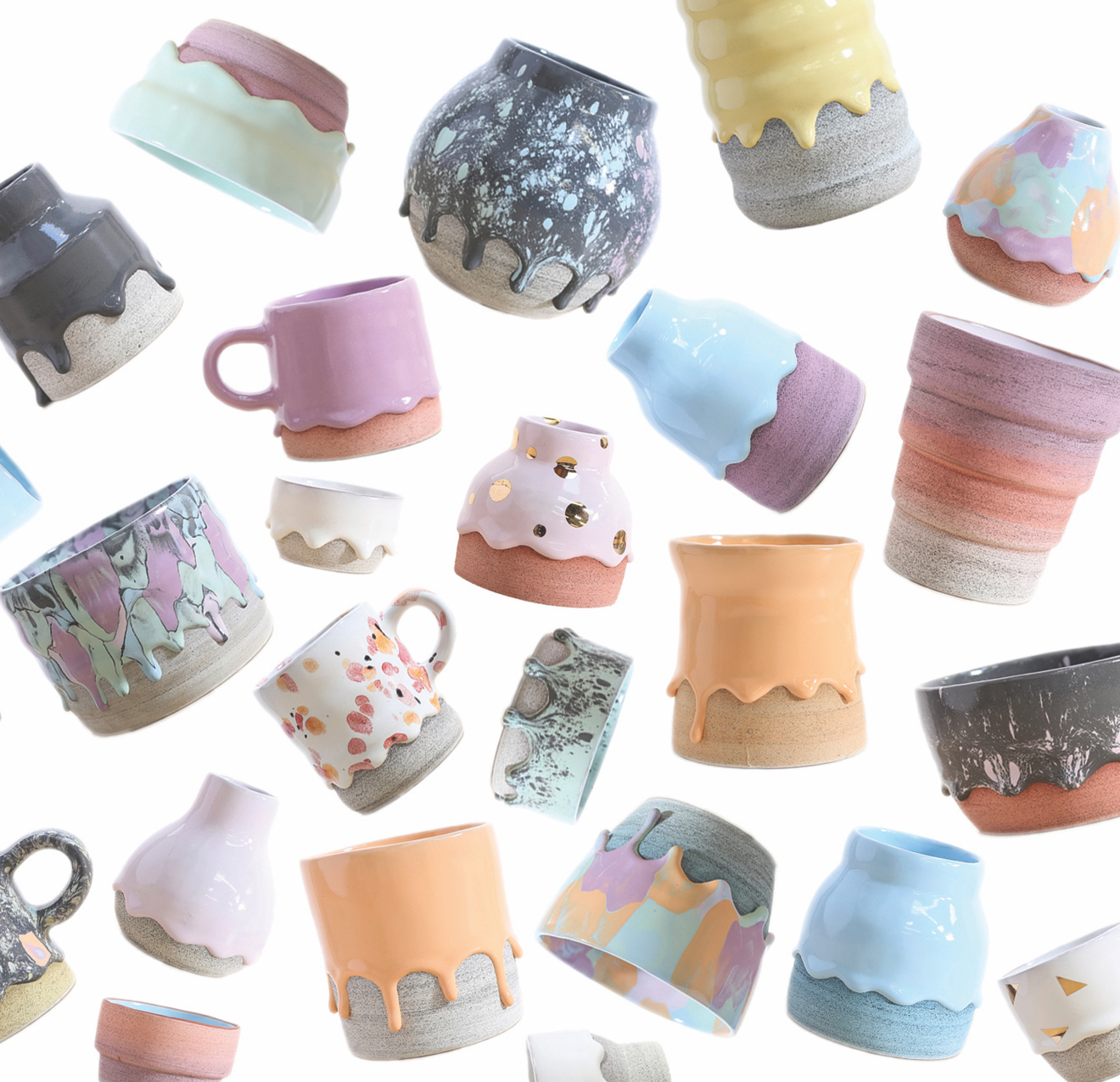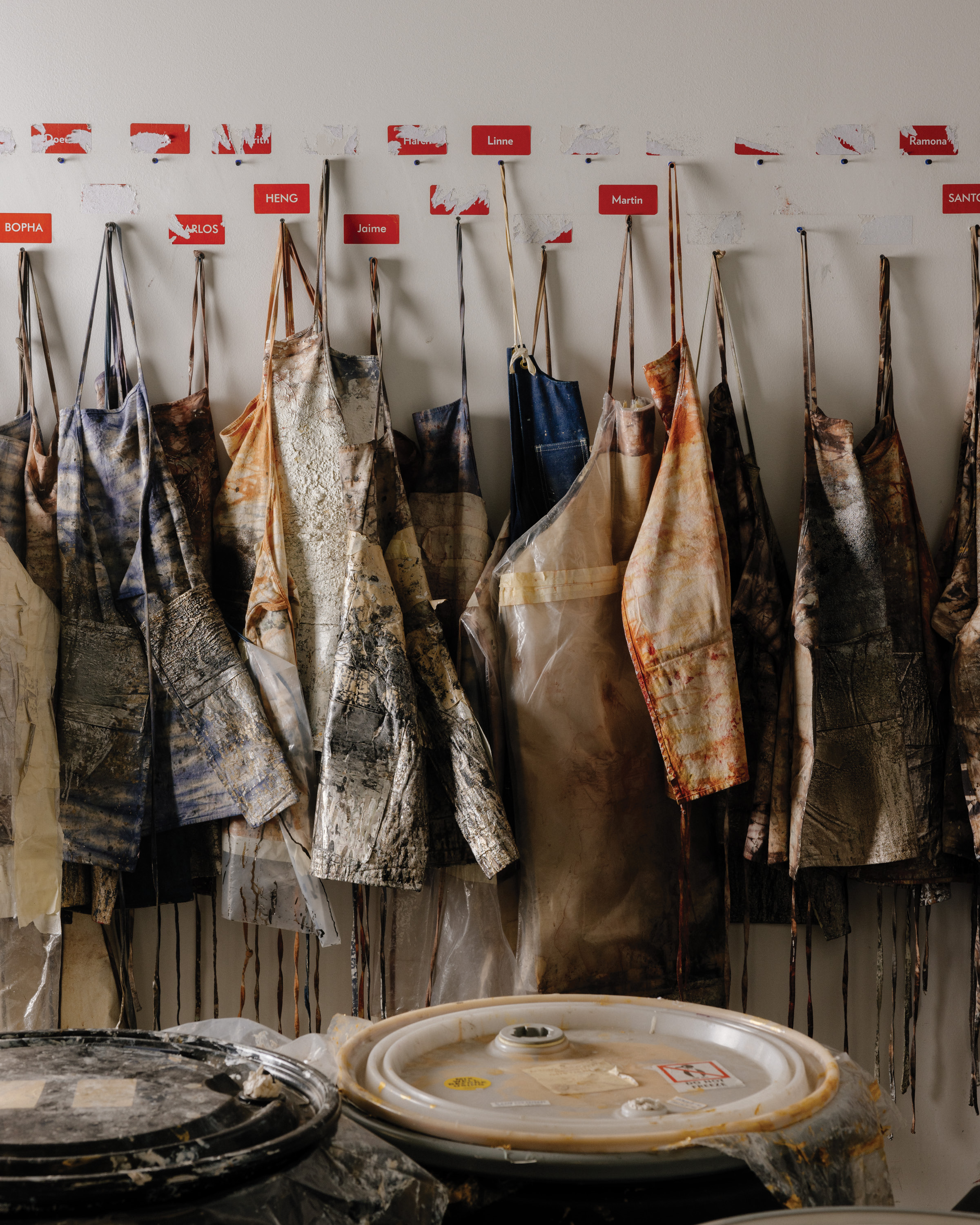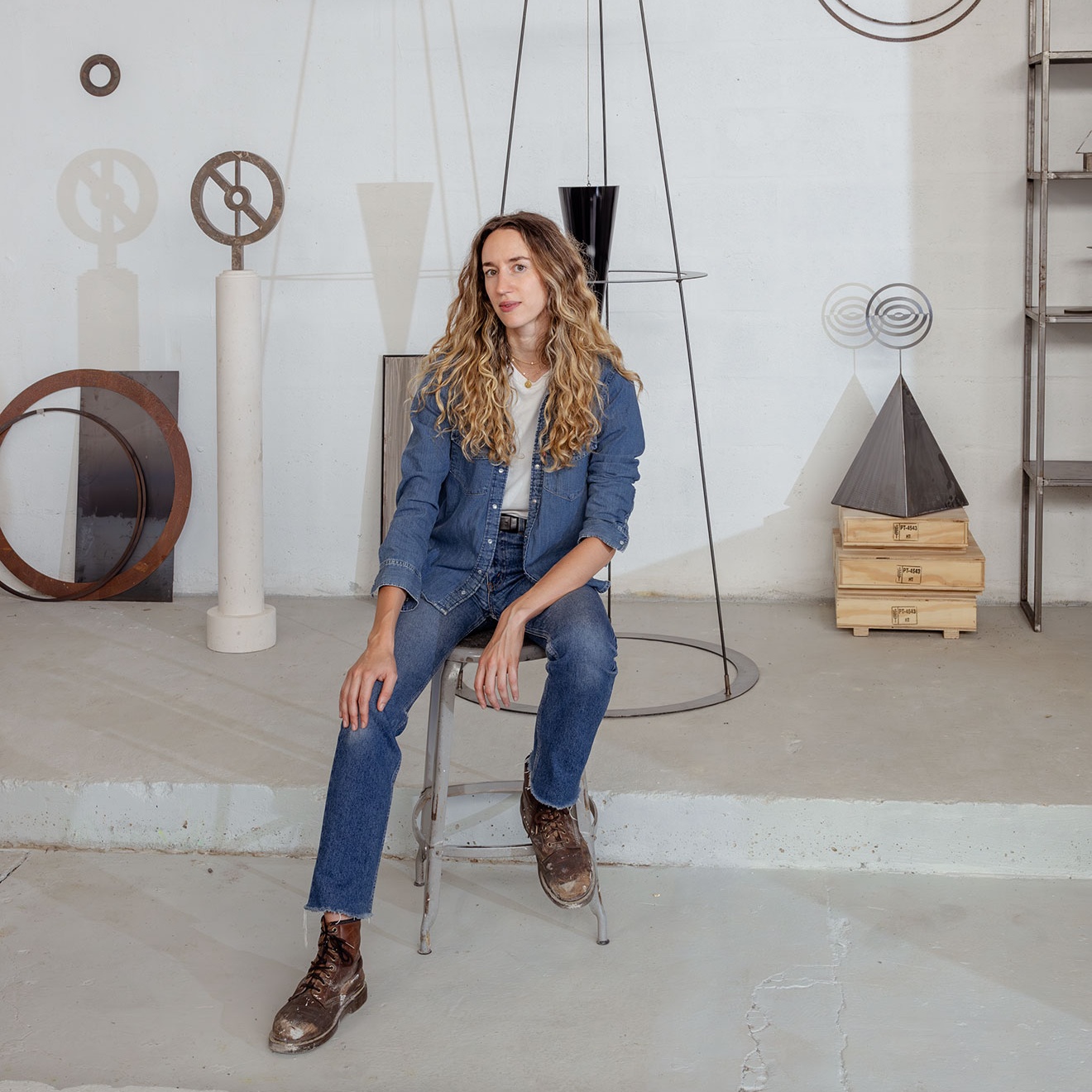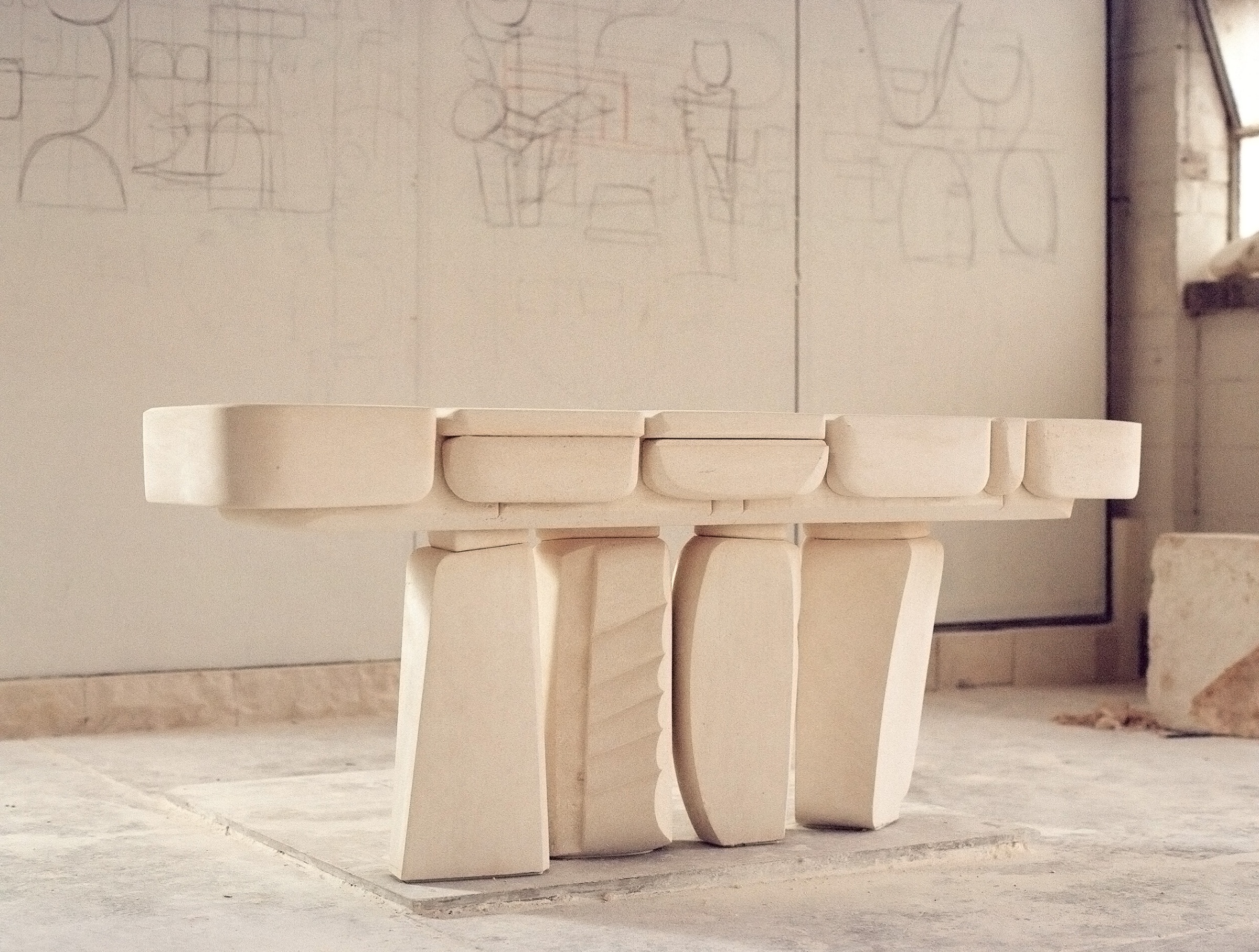Visit the Brian Giniewski web shop, and you’ll find ceramic vessels with names like “Fluff,” “Toast,” “Sherbet,” “Creamsicle,” and “Stardust.” That tells you just about everything you need to know about the whimsical pottery line.
Giniewski, who launched his business in 2016, is pretty whimsical himself. As an art student he was always drawn to vibrant colors and indulgent texture, so when he was unable to find those kinds of surfaces in ceramics, he created them. Giniewski’s pots look like they belong in a pastry shop, with dreamy-hued glazes that drip down the sides of mugs and vases like thick icing.
I talked to Giniewski from his sun-drenched studio just after he and his wife Krista moved into their new house in Philadelphia. Krista is a full-time clinical psychologist, but spends her spare time helping run the business.
Giniewski’s work is infused with joy and levity, whether he’s building a machine to sprinkle plates with rainbow flecks, experimenting with glaze formulas, or cooking lunch for his team.
Sixtysix: What is your studio like?
Giniewski: There used to be a huge textile industry here on the the eastern side of Philadelphia, so there are all these beautiful old mill buildings. The space that we’re in is called Globe Dye Works—it used to be a thriving textile dye company. We use the entire fourth floor of the building, which is 6,500 square feet. We have our production studio, a plaster and rubber mold making area, and some space that we rent to other artists. The studio is wide open. It has these huge windows on all sides so we get lots of natural light.
I really like the idea that we are using infrastructure from the industry that used to be here and redefining it for today. We are adding to the narrative of things being made in Philadelphia.
Real estate is still affordable in this neighborhood, which is important because we need a lot of space to keep enough pieces in progress to stay in business. A big part of my brand philosophy is keeping the pieces accessible, so we work hard to keep prices between $20 and $100. I started this business selling to my friends and family, so I always want it to be a product that people in my bubble can afford to collect.
Tell me about the process of creating a pot.
It takes a full month for a piece to go through the whole process—starting with raw clay, going through different glazings, and being fired a number of times.
There are probably 400 pieces in the works right now, all at different levels of completion. When we take custom orders for a store, we make a production checklist where everybody signs off on what part they’ve done. That spreadsheet has 12 to 15 columns to show when the pot was made, when it was cleaned up, when we put the first coat of glaze on, when we put it into the kiln, etc. Looking at it on paper we are seeing the history of the piece traveling through each station and interacting with each person.
There is so much care and finesse that has to happen with every part of the processes, and there are so many opportunities for things to go wrong. So when a piece comes out beautiful at the end it’s a real demonstration of teamwork and efficiency.
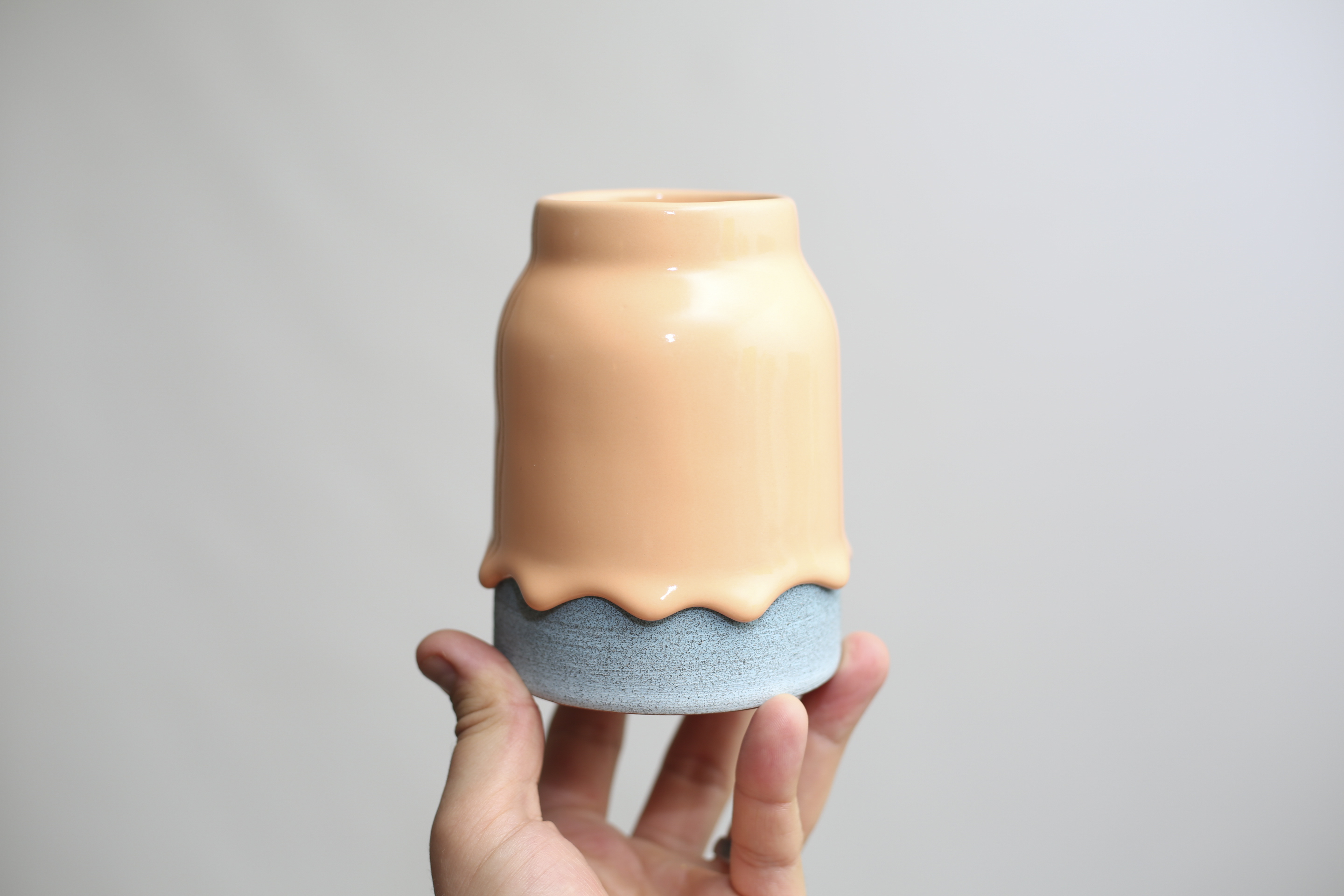
How do you approach marketing as a small business owner?
People respond to the idea of an artist or a maker having an individual interaction with them. I include a handwritten note in every box that I send out, and we are very engaged on social media. When you’re buying and collecting handmade, you’re trying to forge some sort of connection with the person that made it. People buy our work not only because they think it’s beautiful, but because they believe in our story and want to support us.
Since I went full time with this two years ago, my wife and I decided we would always do all the photography, social media, and advertising ourselves. It’s our story, our eye, and our vision. We don’t have the best equipment, but I think the way that we show our products and our social media presence feels honest to who we are. That is something we are uncompromising about.
People buy our work not only because they think it’s beautiful, but because they believe in our story and want to support us.
Tell me about how you collaborate with your wife, Krista.
Krista is a clinical psychologist and she didn’t know much about art or ceramics before we met, but now she’s a super involved part of the brand. It’s so interesting to see her perspective because it’s completely different than mine.
Krista has this great big picture understanding. Her psychologist brain is so valuable for me because I get really enthusiastic and emotional and she helps me recenter.
All of the really funky multi-colored pieces like Sherbet and Stardust are surfaces that Krista developed, and a lot of them were pretty antithetical to my understanding of the ceramic process. Because of my training I never would have considered those methods as valid options. But she doesn’t have that baggage so she just picks up something and experiments.
Sometimes pieces come out with minor imperfections, and I always learned that if a piece comes out of the kiln and it’s not perfect you smash it with a hammer. Krista will take the flawed pieces and try out unusual finishes and applications, and more often than not something really beautiful comes out of it. The way that we collaborate in the studio has influenced the growth and development of the business over the last couple years because we have such different ways of thinking.

Dinner plate by Brian Giniewski. Courtesy Brian Giniewski.
What is your favorite part of your day-to-day work?
Problem solving in general is the part that I get most excited about. It’s carried over from when I was teaching at the university level and making art for exhibition. Problem solving for each individual sculpture was so interesting to me, and now I can apply it to this big studio with all these moving pieces.
I’m constantly building little gadgets and tools to make the process more efficient, ergonomic, and timely. Or just to make it more fun. Everybody in the studio laughs when they see me get locked onto a little project like that, but I love when there’s some element of engineering and building to help me accomplish a task.
Something that we’ve always focused on in the studio, even before we were taking big orders, is designing tools and systems that can be scaled up. I never want to take an order that I can’t fill, so we try to work with an industrial sensibility, even though we’re not working at an industrial scale.
What’s an example of a tool you’ve created recently?
If you look at the dinner plates that we just started making, they have all these pops of color all over them. We do a lot of experimentation developing new colors, so we end up with hundreds of little cups of dry glaze. I’m creating a machine that I can dump all of those dry glazes into, and it vibrates them through a series of screens and sorts them out into different particle sizes. So I’m decorating those dinner plates with little pieces of glaze that were used for testing.
I like the idea because it takes something that would be a waste product and it turns it into a special unique surface, and I also got to make this goofy machine that does this great little job.
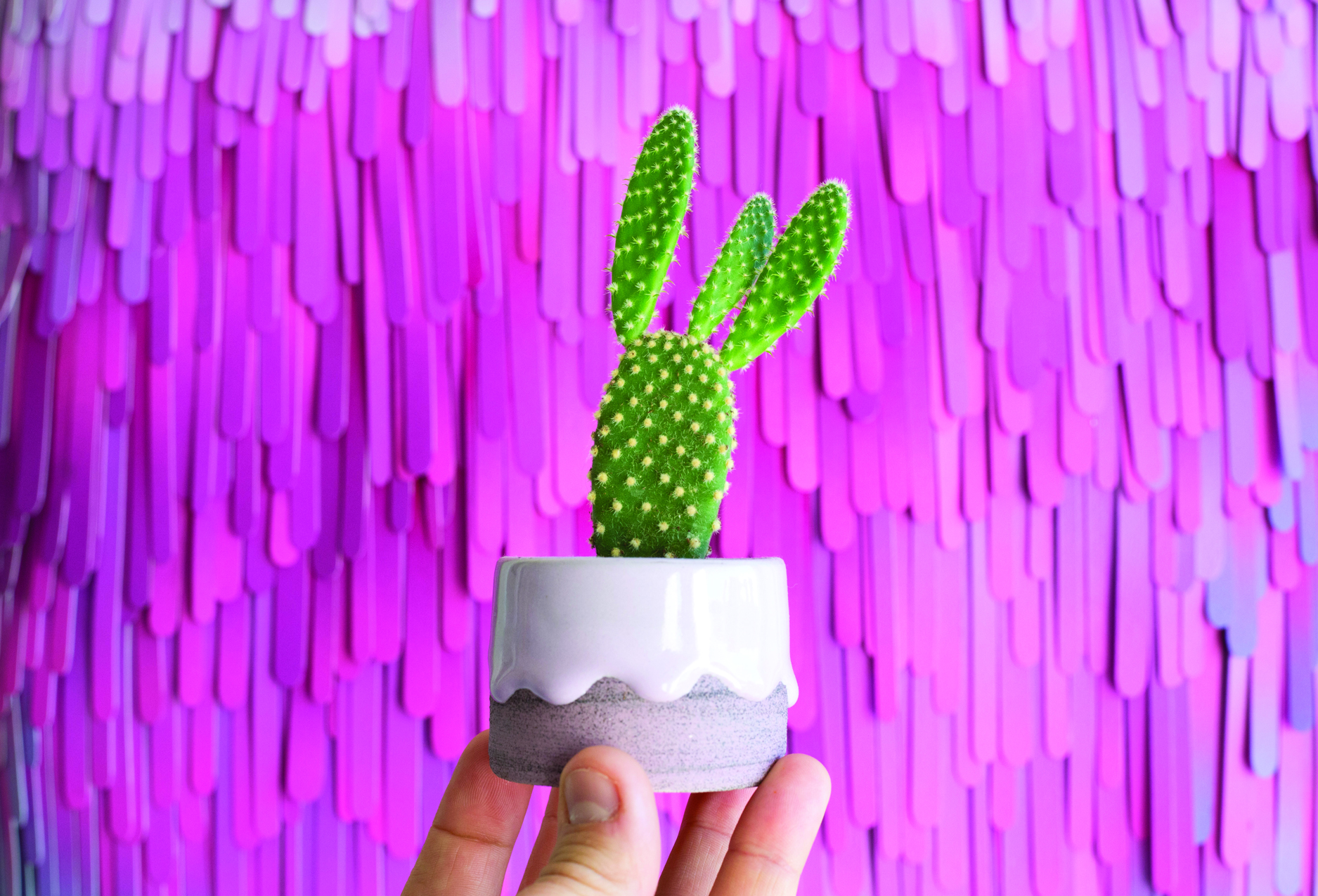
Happy Cactus by Brian Giniewski. Courtesy Brian Giniewski.
Tell me more about creating your own glazes.
I always loved bright, clean colors, but so much of ceramics is in neutral earth tones and I just wasn’t finding the surfaces that I loved. That’s what made me start designing my own glazes and trying to come up with these pastry-like, gooey, plastic-y surfaces.
The glazes are all recipes that I’ve developed over the past five years. To test them we make triangular tiles with 21 little divots, and mix up three different base glazes in 21 different blends. Then we all look as a group and choose the most interesting or unusual colors.
The level of chemistry and detail that goes into making glazes in the studio is pretty complicated, but we know that it’s the thing that is protecting us from being ripped off by industry. We see stores trying to replicate our products and get that juicy, drippy surface, but there’s so much handwork and care that we put into the glaze development and firing process that it just can’t be reasonably imitated on a large scale.
Can you describe how you get those signature drips?
The actual process is pretty proprietary, but I will say that we use a very specific custom glaze recipe that I designed myself. We also fire in a computer controlled kiln so the kiln knows exactly how fast to fire up to a certain temperature. There are different critical temperatures it has to hit throughout the firing and glazing process to get the glaze to behave like that.
The difference of one minute determines whether a piece has a beautiful dramatic drip or if the drip goes all the way down and sticks to the kiln shelf, so we’re working with very tight tolerances. We fire in small batches of 50 or 60 pots, and we put a lot of care into how they are placed in the kiln. The final step is always nerve racking because at that point we’ve already invested so much time into the pieces.
We used to lose a lot more pots, and now that we’ve gotten so precise with the process we lose less, but it still happens. We push it to the limit to get that drip right at the critical point.
Krista also collects pieces with minor imperfections and periodically posts flash sales on Instagram where she sells them for half price. The pieces sell out in like ten minutes and then she removes the post like it was never there. I love that it gives people the opportunity to buy pieces at an even more affordable price and reduces waste.
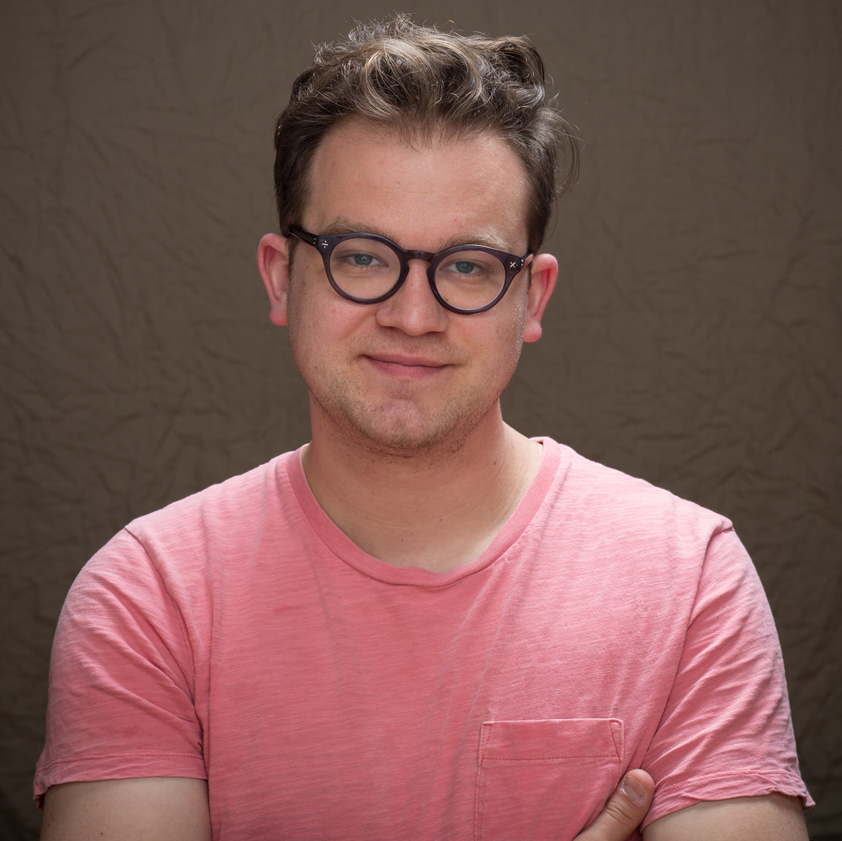
Brian Giniewski. Courtesy Brian Giniewski.
You just moved into a new house! How would you describe your personal design style?
The art that we collect lives in the same world as the drippy pots. We have a lot of stuff that is colorful, funny, and whimsical. I love Group Partner, Dan Flanagan, Joshua Abelow, Lauren Clay, and Molly Anne Bishop. The most recent piece we bought is an illustration by Gabriel Alcala called Night Swimming. It’s a naked man and woman and you’re seeing what’s above and below the waterline—it’s so funny and beautiful.
After building out the whole studio space ourselves earlier this year, Krista and I feel empowered to be more ambitious with the house. We took a wall down as soon as we moved in, and now we’re doing major renovations. There is something about being a maker and just understanding how things are made that empowers you to not accept pre-existing conditions. We’re trying to make this house exactly what we want it to be, and I think that’s a direct result of what we’ve done at work.
How do you unwind after a long day in the studio?
Krista and I tend to want to work all the time. She just gets stronger as the night goes on! After seeing ten patients she will come home and want to do a major website update or spend three hours on QuickBooks. If we’re not working on something for the business we’re working on something for our house.
We don’t give ourselves a lot of downtime, but when we’re working we’re doing something together that we both really believe in. It’s cool that our intimate time is a collaborative creative effort.
When I have time by myself and Krista is at yoga or something I love to make music. I play guitar, drums, and keyboard. I love that it’s a creative form that’s not connected to my livelihood. I never have to perform, I never have to make money from it, it is purely for fun. We’re setting aside a little space in the basement in the new house that’s going to be my music room.
What kind of music do you play in the studio?
We have an Alexa that’s connected to the speaker so we can just shout things out, and we take turns choosing. I love a lot of indie girl bands like Girlpool, Jay Som, Japanese Breakfast, Adult Mom, and Julien Baker. My absolute favorite band is SALES, and I’ve actually become friends with them through Instagram. They came to the studio a couple of weeks ago when they were in town, and I showed them how to throw pots and glaze plates.
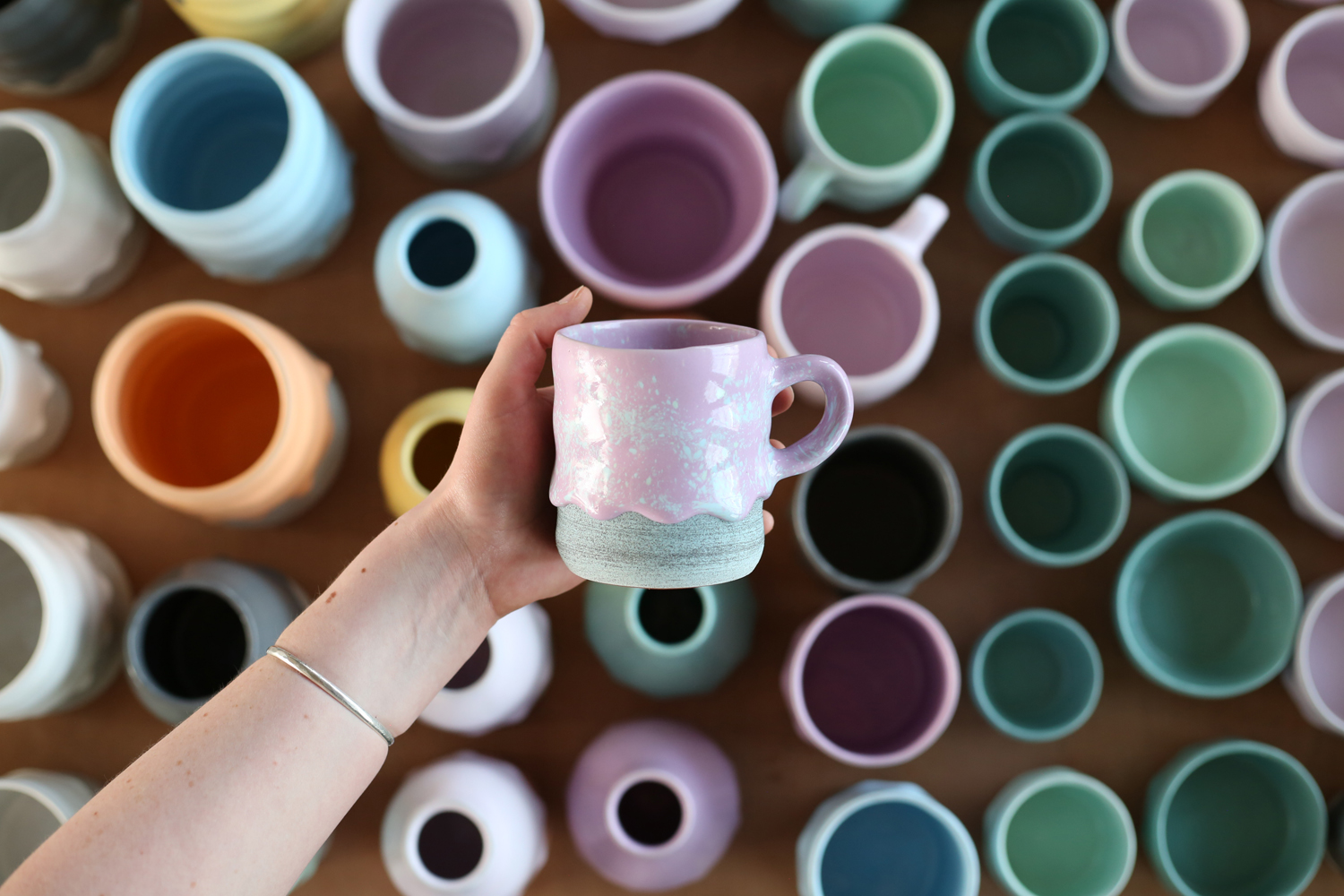
Fluff Mug by Brian Giniewski. Courtesy Brian Giniewski.
What is something people wouldn’t know about the Brian Giniewski Studio?
One of the things that I think is really special about the studio is that we sit down as a family and have a home cooked lunch everyday. It’s one of the benefits that I can offer to people that work here. We take turns cooking and we sit down for a paid hour of eating and talking about what’s going on in the studio, and what’s going on in our personal lives too.
The ritual helps create the culture that I want in the studio. We’re all accountable to each other and look out for each other, which is pretty great.
We mostly make healthy vegetarian meals—a lot of curries and rice and beans. There’s a company in the building that makes salsa and guacamole so sometimes we go down and grab stuff from them. And we always have cake if it’s someone’s birthday or another cause for celebration.
Anything exciting coming up for the business?
We are in the process of collaborating with a brewery here in Philadelphia to make a custom drippy pot beer. It’s going to be this really fruity, juicy beer, and it’s going to have a drippy pot label on it. I’ve always wanted to design a beer can. We are working with them on the flavor profile, what it’s going to be called, and how its going to look. It’s still in the early phases but we’re hoping to release it in July.
